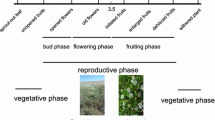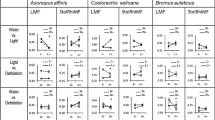Summary
Eriophorum vaginatum is a tussock-forming member of the Cyperaceae, widespread in the arctic tundra, and a common food item for grazing herbivores on the Alaskan North Slope. Populations of this sedge at Atkasook, Alaska, were subjected to a variety of simulated grazing experiments to determine tiller responses to frequent and intensive defoliation.
The intial, short-term response of Eriphorum to defoliation was an increase in leaf production at the expense of belowground structures. Multiple defoliations, however, resulted in proportionately greater reductions in leaf weight than leaf area. Leaf blades of defoliated plants weighed 0.71 mg/cm of length, compared to an average weight/length ratio of 0.91 mg/cm in control plants. Declines in leaf production were accompanied by weight losses in stem base and sheath components and a curtailment of root growth. Root initiation was reduced by 28 and 63%, respectively, after one and two seasons of multiple defoliations, and the depth of penetration of these annual roots was reduced substantially. Total root biomass was reduced 24% in the least severe defoliation treatment and 85% in the most severe treatment. The allocation of dry matter into new tillers on defoliated plants, relative to new tiller production of control plants, was reduced by 75% after two seasons of defoliation, although equivalent numbers of tillers were initiated. The reduced biomass of daughter tillers was restored to levels observed in control plants during the season of rest following the season of multiple defoliation. Sexual reproduction was significantly depressed in the most severe defoliation treatment and stimulated by the least severe treatment. Defoliation treatments of intermediate severity had no significant impact on flower initiation.
Over 80% of the tillers subjected to complete defoliation at 10-day intervals for one entire growing season survived, overwintered and initiated growth the following season. Recovery from multiple defoliations was partially achieved by the stimulated growth and extended longevity of older leaves on the tiller, although one season of rest was not enough to fully replenish weight losses of storage organs. Tillers were capable of withstanding more defoliation events when clipping was initiated early in the growing season. Biomass of storage organs of tillers subjected to multiple defoliations imposed at 10-day intervals for two entire growing seasons was 34% above the estimated minimum biomass necessary for tiller survival. The data suggest that Eriophorum tillers can survive 100% leaf removal at 10-day intervals for 50 to 75% of their estimated three to four year lifespan.
Similar content being viewed by others
References
Archer S, Tieszen LL (1980) Growth and physiological responses of tundra plants to defoliation. Arctic and Alpine Res 12:531–552
Baker J, Hunt O (1961) Effects of clipping treatments and clonal differences on water requirements of grasses. J Range Manage 14:216–219
Batzli GO (1975) The role of small mammals in Arctic ecosystems. In: Small Mammals: Their productivity and population dynamics. Vol. 5. Inter Biol Programme, Cambridge Univ. Press, Great Britain pp 243–268
Batzli GO, Brown J (1976) Research on arctic tundra environments (RATE): The influence of grazing on arctic tundra ecosystems. Arctic Bull 2:153–160
Batzli GO, Jung H (1980) Nutritional ecology of microtene rodents: Resource utilization near Atkasook, Alaska. Arctic and Alpine Res 12:483–499
Batzli GO, Pitelka FA (1975) Vole cycles: Test of another hypothesis. Amer Nat 109:482–487
Bliss LC (1975) Tundra grasslands, herblands, and shrublands and the role of herbivores. Geosci and Man 10:51–79
Bokhari UG (1977) Regrowth of western wheatgrass utilizing 14C-labeled assimilates stored in belowground parts. Plant and Soil 48:115–127
Buwai M, Trlica MJ (1977) Multiple defoliation effects on herbage yield, vigor, and total nonstructural carbohydrates of five range species. J Range Manage 30:164–171
Chapin FS (1977) Nutrient/carbon costs associated with tundra adaptations to a cold nutrient-poor environment. In: Proc. Circumpolar Conference on Northern Ecology. Nat Res Council of Canada, Ottawa, pp 1183–1194
Chapin FS (1980) Nutrient allocation and responses to defoliation in tundra plants. Arctic and Alpine Res 12:553–563
Chapin FS, Johnson DA, McKendrick JD (1980) Seasonal movement of nutrients in plants of differing growth forms in an Alaskan tundra ecosystem: Implications for herbivory. J Ecol 68:189–209
Chapin FS, Slack M (1979) Effect of defoliation upon root growth, phosphate absorption, and respiration in nutrient-limited tundra graminoids. Oecologia (Berlin) 42:67–79
Chapin FS, Van Cleve K, Chapin MC (1979) Soil temperature and nutrient cycling in the tussock growth form of Eriophorum vaginatum L. J Ecol 67:169–179
Cody WJ (1964) Reindeer range survey. Plant Res Inst Can Dept Agric Ottawa
Cody WJ (1965) Plants of the MacKenzie River Delta and reindeer grazing preserve. Plant Res Inst Can Dept Agric Ottawa
Coyne PI (1969) Seasonal trend in total available carbohydrates with respect to phenological stage of development in eight desert range species. Ph.D. Disser, Utah State Univ, Logan p 164
Davidson JL, Milthorpe FL (1966) The effect of defoliation on the carbon balance in Dactylis glomerata. Ann Bot 30:185–198
Davis WEP (1960) Effect of clipping at various heights on characteristics of regrowth in reed canarygrass (Phalaris arundinacea L.). Can J Plant Sci 40:452–457
Detling JK, Dyer MI, Procter-Gregg C, Winn DT (1980) Plantherbivore interactions: Examination of potential effects of bison saliva on regrowth of Bouteloua gracilis (H.B.K.) Lag Oecologia (Berlin) 45:32–34
Detling JK, Dyer MI, Winn DT (1979) Net photosynthesis, root respiration and regrowth of Bouteloua gracilis following simulated grazing. Oecologia (Berlin) 41:127–134
Ellison L (1960) Influence of grazing on plant succession of rangelands. Bot Rev 26:1–78
Evans PS (1972) Root growth of Lolium perenne L. III. Investigations of the mechanisms of defoliation-induced suppression of elongation. New Zea. J Agric Res 15:347–355
Everett KR (1980) Distribution and variability of soils near Atkasook, Alaska. Arctic Alpine Research 12:433–446
Gifford RM, Marshall C (1973) Photosynthesis and assimilate distribution in Lolium multiflorum Lam. following differential tiller defoliation. Aust J Biol Sci 26:517–526
Goodman GT, Perkins DF (1968) The role of mineral nutrients in Eriophroum communities. III. Growth response to added inorganic elements in two E. vaginatum communities. J Ecol 56:667–683
Grant SA, Lamb WIC, Kerr CD, Balton GR (1976) The utilization of blanket bog by grazing sheep. J Appl Ecol 13:857–869
Haber A, Runyon RP (1973) General Statistics. Addison-Wesley Publ Co, Inc Reading, Mass p 401
Haugen RK, Brown J (1980) Coastal-Inland distributions of summer air temperature and precipitation in northern Alaska. Arctic Alpine Research 12:403–412
Hendrix SD (1979) Compensatory reproduction in a biennial herb following insect defloration. Oecologia (Berl) 42:107–118
Heslop-Harrison J (1957) The experimental modification of sex expression in flowering plants. Biol Rev 32:38–91
Hickman JC, Pitelka LF (1975) Dry weight indicates energy allocation in ecological strategy analysis of plants. Oecologia (Berlin) 21:117–121
Hodgkinson KC, Smith NG, Miles GE (1972) The photosynthetic capacity of stubble leaves and their contribution to growth of the lucerne plant after high level cutting. Aust J Agric Res 23:225–238
Hopkinson JM (1966) Studies on the expansion of the leaf surface. VI. Senescence and the usefulness of old leaves. J Exp Bot 17:762–770
Hultén E (1968) Flora of Alaska and Neighboring Territories. Stanford Univ. Press, Stanford, Calif p 1008
Hyder DN (1972) Defoliation in relation to vegetative growth. In: The Biology and Utilization of Grasses, Youngner VB McKell CM (eds). pp 304–317. Academic Press, New York. p 426
Jameson DA (1963) Responses of individual plants to harvesting. Bot Rev 29:532–594
Johnson DA, Tieszen LL (1976) Aboveground biomass allocation, leaf growth and photosynthesis patterns in tundra plant forms in Arctic Alaska. Oecologia (Berlin) 24:159–173
Kamstra LD, Schentzel DL, Lewis JK, Elderkin RL (1968) Maturity studies with western wheatgrass. J Range Manage 21:235–239
Kelsall JP (1968) The migratory barren ground caribou of Canada. Can Wildl Serv Monogr No 3. p 339
Komarkova V, Webber PJ (1980) Two low arctic vegetation maps at Atkassok, Alaska. Arctic and Alpine Res 12:442–447
Krebs CJ (1964) The lemming cycle at Baker Lake, Northwest Territories, during 1959–1962. Arctic Inst No Amer Tech. Paper No 15, p 105
Mattheis PM, Tieszen LL, Lewis MC (1976) Responses of Dupontia fischeri to simulated lemming grazing in an Alaskan arctic tundra. Ann Bot 40:179–197
McCarty EC, Price R (1942) Growth and carbohydrate content of important mountain forage plants in central Utah as affected by clipping and grazing. USDA Tech Bull. No 818. Washington DC. p 51 (1942)
Menke JW (1973) Effects of defoliation on carbohydrate reserves, vigor, and herbage yield for several important Colorado range species. PhD Disser, Colo State Univ, Fort Collins. p 283
Mooney HA, Billings WD (1965) Effects of altitude on carbohydrate content of mountain plants. Ecology 46:750–761
Owensby CE, Paulsen GM, McKendrick JD (1970) Effect of burning and clipping on big bluestem reserve carbohydrates. J Range Manage 23:358–362
Pearsall WH (1950) Mountains and Moorlands. Collins, London. p 312
Rickert DA, Tedrow JCF (1967) Pedologic investigations on some aeolian deposits of northern Alaska. Soil Sci 104:250–262
Rockwood LL (1974) Seasonal change in the susceptibility of Crescentia alata leaves to the flea beetle Oedionychus sp. Ecology 55:142–148
Smirnov VS, Tokmakova SG (1971) Preliminary data on the influence of different numbers of voles upon the forest tundra vegetation. Annales Zoologici Fennici 8:154–156
Smirnov VS, Tokmakova SG (1972) Influence of consumers on natural phytocenoses' production variation. In: Tundra Biome. Proc IV Inter Meeting Biol Productivity of Tundra. Wielgolaski FE, Rosswall T (eds) pp 122–127. Leningrad, USSR
Smith D (1964) Winter injury and the survival of forage plants: A review. Herb Abstr 34:203–209
Spetzman LA (1959) Vegetation of the arctic slope of Alaska. US Geol Surv Prof Paper No 302 (B), 19–58
Struik GJ (1967) Growth habits of dandelion, daisy, catsear, and hawkbit in some New zealand grasslands. NZJ Agric Res 10:331–344
Terri JA (1974) Periodic control of flowering of a high arctic plant species by fluctuating light regimes. Arctic and Alpine Res 6:275–279
Tieszen LL, Archer S (1979) Physiological responses of plants in tundra grazing systems. In: Special Management Needs of Alpine Ecosystems. Johnson DA (ed), Range Sci Series No 5, Soc Range Manage, Denver, CO pp 22–43
Tieszen LL, Johnson PL (1968) Pigment structure of some arctic tundra communities. Ecology 49:370–373
Tikhomirov BA (1959) Relationship of the animal world and the plant cover of the tundra. Bot Institute, Acad Sci, USSR. (Trans E Issakoff and TW Barry, Boreal Institute, Univ Alberta). p 87
Trlica MJ, Buwai M, Menke JW (1977) Effects of rest following defoliations on the recovery of several range species. J Range Manage 30:21–27
Trlica MJ, Cook CW (1971) Defoliation effects on carbohydrate reserves of desert species. J Range Manage 24:418–425
Trlica MJ, Cook CW (1972) Carbohydrate reserves of crested wheatgrass and Russian wildrye as affected by development and defoliation. J Range Manage 25:430–435
Trlica MJ, Singh JS (1979) Translocation of assimilates and creation, distribution and utilization of reserves. In: Aridland Ecosystems: Structure, function and management. Vol I. Perry RA, Goodall DW (eds), Cambridge Univ Press, Great Britain. Inter Biol Programme 16 pp 537–571
Troughton A (1957) The underground organs of herbage grasses. Commonwealth Bur Pastures and Field Crops, Hurley, Berkshire, Bull No 44, p 163
Wardlaw IF (1968) The control and patterns of movement of carbohydrates in plants. Bot Rev 34:79–104
Wein RW (1968) Biological flora of the British Isles. Ecology 61:601–615
Wein RW, Bliss LC (1974) Soils and vegetation of hummocky terrain. Task Force on Northern Oil Development Report 74-5. p 86
White RG, Trudell J (1980) Habitat preference and forage consumption by reindeer and caribou near Atkassok, Alaska. Arctic and Alpine Res. 12:511–529
Williams SRD (1964) Assimilation and translocation in perennial grasses. Ann Bot 28:419–426
Youngner VB (1972) Physiology of defoliation and regrowth. In: The Biology and Utilization of Grasses. Youngner VB, McKell CM (eds), Academic Press, New York pp 292–303
Author information
Authors and Affiliations
Rights and permissions
About this article
Cite this article
Archer, S., Tieszen, L.L. Effects of simulated grazing on foliage and root production and biomass allocation in an arctic tundra sedge (Eriophorum vaginatum). Oecologia 58, 92–102 (1983). https://doi.org/10.1007/BF00384547
Received:
Issue Date:
DOI: https://doi.org/10.1007/BF00384547




